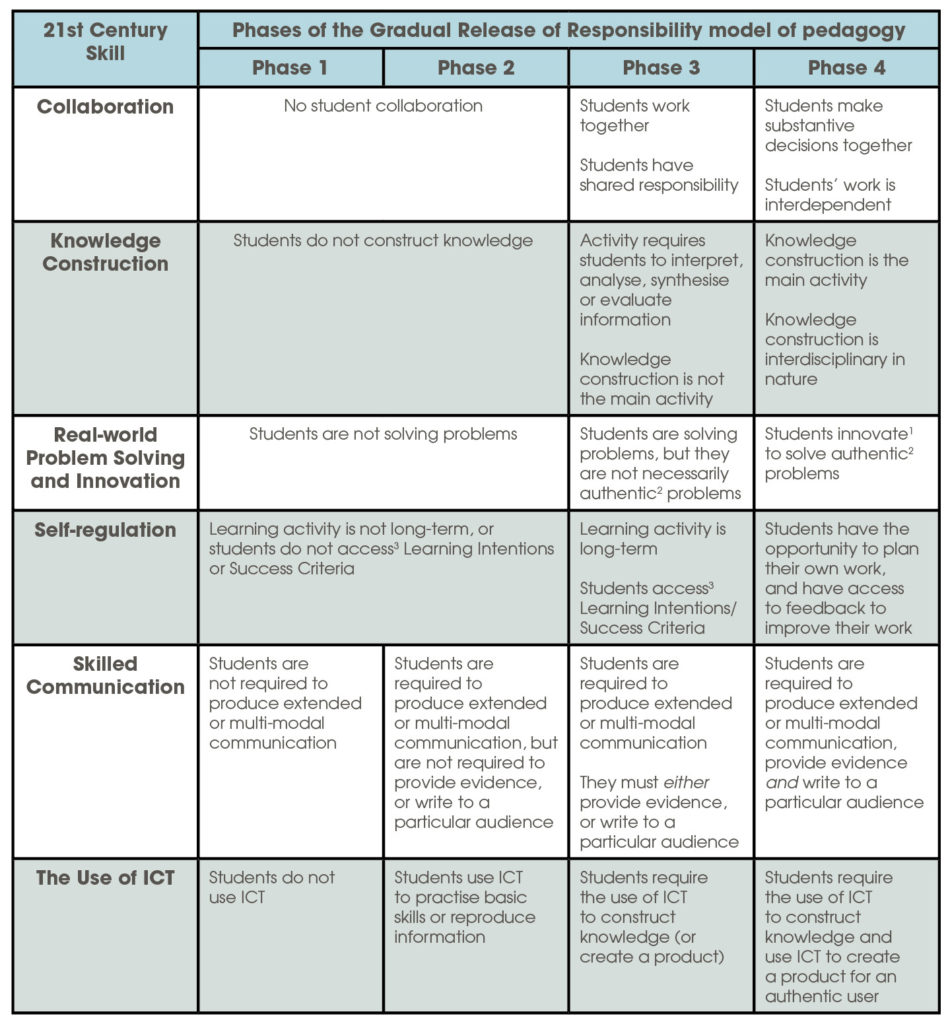By Stephen Pinel
Literacy, 21st century skills, ICT and a common pedagogical framework – these four seem to be flavours of the month in many schools, including mine. What is not evident, however, is how schools blend all of these disparate strategies together into one framework. Too often, the professional development (PD) delivered for each of these strategies is delivered separately, in a piecemeal approach, and in ways that can contradict each other.
This article shares a framework that integrates these four important strategies, so that units of work can be prepared that take students from learning basic skills directly from teacher modelling, right through to collaborative application of these skills against real-world, authentic problems.
It is assumed that people reading this article are across strategies for teaching literacies and are onboard with the use of ICT in education, so it starts by looking at the 21st century skills briefly, with a more detailed look at a pedagogical framework called The Gradual Release of Responsibility. Note that literacy and ICT skills are already explicitly identified in the 21st century skill set used for the purposes of this article.
ICT and 21st Century Skills
The 21st century skills have been hashed over by quite a few different groups over the last 20 or so years. Fundamentally, the 21st century skills are those that employers and the community in general see as valuable for people to contribute economically and socially, as leaders or as active participants, and as entrepreneurs in society. This article uses the 21st century skill set as defined in 21CLD Learning Activity Rubrics (2014), written by the ITL Research Group and funded by Microsoft philanthropic organisation Partners in Learning Network. Their six 21st century skills are:
• collaboration
• knowledge construction
• self-regulation
• real-world problem solving and innovation
• the use of ICT for learning
• skilled communication.
Their definition of the skill set also provides specific examples, and describes what teachers will see students doing at different levels as they develop. As an example, collaboration is defined as follows:
Students work together when the activity requires them to work in pairs or groups to:
• discuss an issue
• solve a problem
• create a product.
Examples of Collaboration

A Rubric for Measuring the Level of Collaboration in an Activity
In this learning activity:
1. Students are not required to work together in pairs or groups.
2. Students do work together but they do not have shared responsibility.
3. Students do have shared responsibility but they are not required to make substantive decisions together.
4. Students do have shared responsibility and they do make substantive decisions together about the content, process, or product of their work but their work is not interdependent.
5. Students do have shared responsibility and they do make substantive decisions together about the content, process, or product of their work and their work is interdependent.
The rubric also assists teachers in identifying how their unit can be improved in each particular dimension.
The Gradual Release of Responsibility (GRR) Pedagogical Framework
GRR is a structured pedagogical framework that, as the name suggests, gradually moves the responsibility for learning from the teacher to the student. There are four distinct phases in GRR:
1. Focused lesson: the skill or process to be taught is explicitly modelled by the teacher, with students passively observing.
2. Guided instruction: students attempt the skill or process modelled in the first stage, one step at a time, with teacher support or guidance, rather than modelling.
The first two phases are generally the easy part of GRR for teachers, because they control the classroom activity entirely, and students do not need to be highly engaged for success. It is enough that students are motivated by the desire to avoid negative consequences (detention, parental contact and so on) for them to succeed at learning activities at this stage, if the activity is within their capacity. Strategies such as learning intentions and success criteria will not generally be helpful for students as they are simply mimicking what their teacher is showing them. Philip Schlechty describes this level of engagement as ritual compliance.
3. Collaborative learning: students continue to improve their skills at their own pace, but work collaboratively with their peers rather than the teacher.
In this phase, teachers start to let go of control of classroom activity, and set differentiated goals and tasks for their students. Working collaboratively is a key element of this phase. This is not something that students do well at naturally, so teaching students how to work together to achieve common goals becomes an important role for the teacher. Phase three requires students to be more engaged in their work, as they are under less direct teacher supervision. As students start to take ownership of their own learning, learning intentions and success criteria also start to become important elements of teaching at this phase. Flipping can be a useful technique in this phase to allow more classroom time for collaboration and peer coaching. Philip Schlechty describes the level of engagement required for success in this phase as strategic compliance.
4. Independent tasks: students apply their learning in new situations.
Phase four is the point in learning where teachers invite students to apply their knowledge and skills in new situations that are authentic and involve real-world problem solving. It is in this phase that students have the first real opportunity to choose an application for their new skills that are of personal interest to themselves, with guidance or advice from their teacher.
For success in this phase, students need to show the full characteristics of engagement as described by Schlechty; that is, both high commitment and high attention to the task at hand. Students must be intrinsically motivated, so it is important that the teacher does not arbitrarily assign a task, but involves the students in identifying a task to work towards that is seen to be authentic for the students. That is, learning intentions and success criteria must be co-constructed. Problem-based learning, or project-based learning (PBL) can be a good a teaching technique that meets these requirements.
Integration of GRR with 21st Century Skills
In an initial attempt to integrate GRR with 21st century skills, Table 1 shows a mapping between specific activities related to each 21st century skill and the GRR phase in which that activity should be observed.

1. In the 21CLD document, innovation is defined as putting students’ ideas or solutions into practice in the real world.
2. The authenticity of a product/problem can only be decided by the audience or client, in this case, students. This reinforces the idea that students must be involved in planning which problems to solve, as the students themselves must see the problem as authentic, not just the teacher.
3. Accessing learning intentions and success criteria is defined as these being both available to students and actively being used by students. Simply having them available for students is not enough to say they are being accessed by students.
Table 1: Student activities evident at different phases of the GRR model of pedagogy, mapped against 21st century learning design
Stephen is Head of Science at Unity College, Caloundra. He was previously Head of Science at Proserpine SHS where he was heavily involved in eLearning, leading a team of eLearning Mentors to develop innovative and engaging curricula school wide. Stephen has taught in both the independent and state sector in Queensland, as well as abroad in the UK and at the Rotterdam International Secondary School. He blogs on engagement at


Latest posts by Education Technology Solutions (see all)
- Keypath Education Launches AI-enabled Short Course Platform to Drive Career Progression for busy Professionals - February 19, 2025
- Lumify Work Partners with AI CERTs™ to Bring Cutting-Edge AI Certifications to ANZ & PH - February 5, 2025
- BenQ Launches First EDLA-Certified Interactive Displays for Education with Google Mobile Services (GMS) - November 17, 2023
There are 3 comments
Add yoursPost a new comment
You must be logged in to post a comment.


[…] Student & Instructor Perceptions on Libraries and Research « The Gale Blog. Transforming the Library Profession. Technological advancements are driving an increasingly interconnected global landscape, which contributes to rapid political, economic, social, and environmental change. Faster communication systems and enhanced access to information bind countries, economies, and businesses in far more complex ways than we have ever conceived. This interdependence on a global scale makes risks such as rising socioeconomic inequality particularly pernicious because of the inherent instability of weak economies and social fragility. Bringing It All Together: Literacy, ICT and the 21st Century Skills. […]
[…] https://www.educationtechnologysolutions.com.au/2017/06/bringing-it-all-together-literacy-ict-and-th… […]
[…] Pinel, S. (2017). Education Technology Solutions. Bringing it all together: Literacy, ICT and the 21st Century Skills. Retrieved from https://www.educationtechnologysolutions.com.au/2017/06/bringing-it-all-together-literacy-ict-and-th… […]